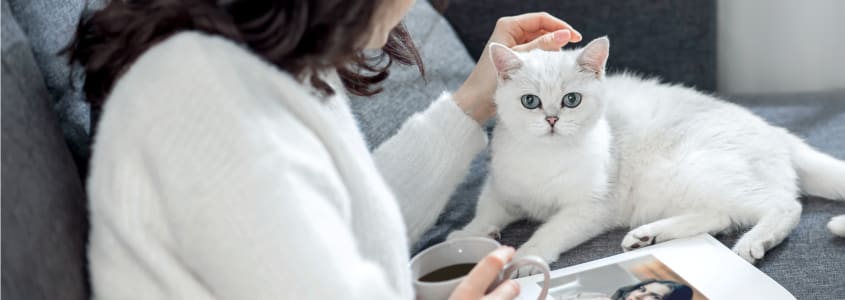
Not all pet injuries need a vet, but knowing how to treat them and when to visit the vet is crucial. In this blog, our Denver veterinarians share guidance on giving first aid to help your pet with injury from home.
Pets Injury
Regardless of your pet's lifestyle, accidents can happen, causing grazes, scrapes, cuts, or other injuries that require care. Even seemingly minor injuries can lead to serious infections. If you're unsure about seeking vet care, it's wise to be cautious and reach out to your veterinarian. Taking your pet to the vet right after an injury can save money and prevent your pet from experiencing unnecessary pain.
Pets Injury That Need Veterinary Care
Even though you can treat some pets' injuries at home, there are also situations where a pet's injury needs to be addressed by a veterinarian as quickly as possible. Here is a list of injuries that require veterinary care:
- A wound with a large object lodged in it (i.e.: a piece of glass)
- Injuries around the eyes, head or that lead to breathing difficulties
- Skin that has been torn away from the flesh below (often occurs during dog fights)
- Animal bites (these may look small but become infected very, very quickly)
- Wounds caused by a car accident or other trauma
First Aid Kit For Pets
It's a good idea to have a pet first aid kit and some basic knowledge ready in case your pet gets a small injury. Here's a list of items you should keep on hand to be prepared for such situations:
- Sterile bandages
- Tweezers
- Clean towels or rags
- Self-adhesive bandages
- Bandage
- Soap or cleaning solution
- Antimicrobial ointment suitable for pets
- Pet antiseptic solution (i.e.: 2% chlorhexidine)
- scissors
- Spray bottle
- Muzzle
Giving Your Pet First Aid
To help prevent any infections, you should have your pet's injury addressed and cleaned as quickly as possible. Before starting your pet's first aid, you should have someone assist you in restraining your pet and be generally supportive.
If you don't know what to do or if you should take your pet to the vet or not, keep in mind it's always best to be cautious when it comes to your animal friend's health. When in doubt, call your vet, or bring your pet to an emergency animal hospital immediately.
Muzzle Your Pet
If your pet is scared, anxious, or hurt, it might bite when you're trying to help. That's why our team suggests using a muzzle on your injured pet before starting any first aid. It's a smart move to practice putting the muzzle on your pet before any injury happens. This way, your pet will be familiar with the process and the feel of the muzzle, which can help avoid making your pet even more distressed.
Look For Foreign Objects Lodged in The Injury
Inspect the wound to ensure no objects or debris are lodged in it. This is even more so essential if the injury is on the pad of your pet's paw, as they could have stepped on a sharp object. If you can remove the item easily with tweezers, do it very gently. If it's deeply lodged, leave it alone and call your veterinarian immediately, or bring your pet to an emergency vet.
Clean Your Pet Injury
If your pet's paw is hurt, you can softly move the injured paw in a bowl or bucket of warm water. This will help remove any dirt or particles.
If the wound is on another part of your pet's body, you can place your pet in a sink, bath, or shower. Gently let clean water flow over the wound. You might consider adding a bit of gentle baby shampoo, dish soap, or hand soap to the water.
Avoid using strong cleaning products or applying hydrogen peroxide, rubbing alcohol, or harsh items on your pet's skin. These can cause discomfort and slow down the healing process.
Manage the Bleeding
If your pet's wound isn't blocked, gently press a clean towel on it. Small wounds usually stop bleeding in a few minutes, but bigger wounds might take more time. If bleeding doesn't stop within 10 minutes of pressing, reach out to your vet or an emergency animal hospital immediately.
Contain Your Pets Injury
Got antibacterial ointment? Put a little on the wound, then cover it with a fresh bandage or clean gauze. Avoid products with hydrocortisone or corticosteroids. Use a stretchy self-adhesive bandage to keep the gauze secure."
Keep Your Pet From Licking Their Injury
Is your pet trying to lick their wound? They might have to wear a cone or e-collar.
Ongoing Care
You will have to monitor your pet's injury twice a day to make sure it is healing as it's supposed to and that it isn't becoming infected. Clean the injury with water or a pet-safe antiseptic solution twice a day, and contact your vet immediately if the wound becomes inflamed and shows signs of infection.
If you notice increasing redness, swelling, discharge, increasing pain in the wound area, or a bad odor from the injury, contact your vet immediately.
Note: The advice provided in this post is intended for informational purposes and does not constitute medical advice regarding pets. For an accurate diagnosis of your pet's condition, please make an appointment with your vet.

